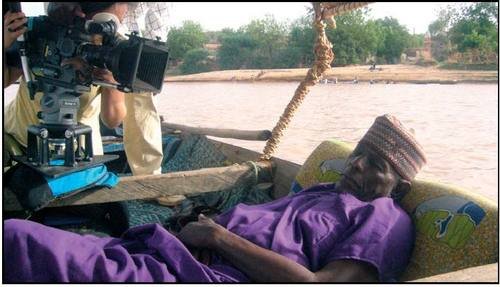25/2/2008
Hagiohygiecynicism
Mamco, Geneve
Four Monographic Shows. The museum has invited Marine Hugonnier to premier her latest film, The Secretary Of The Invisible, a homage to Jean Rouch. Frederic Moser and Philippe Schwinger present one of their most extensive shows to date which features a large group of video installations. Finally, two other exhibitions devoted to Antoine Bernhart and Henri Barande, two artists who are active on the margins of art's traditional network.

For the fourth installment of its exhibition cycle Rolywholyover, Mamco has scheduled a
sequence of four new monographic shows called Hagiohygiecynicism (slated to run from 27 February
to 18 May 2008). Following the screening this winter of Victor Burgin’s videos, Mamco will continue to
highlight moving images. The museum has invited Marine Hugonnier to premier her latest film, The
Secretary Of The Invisible, a homage to Jean Rouch. Frédéric Moser and Philippe Schwinger will also be
mounting one of their most extensive shows to date which will feature a large group of video installations.
Finally, in addition to these shows, the museum has scheduled two other exhibitions devoted to Antoine
Bernhart and Henri Barande, two artists who are active on the margins of art’s traditional network.
Marine Hugonnier (1969, Paris) is scheduled to screen her latest work, The Secretary Of The Invisible,
which she filmed in 2007 in Niger. Travel, landscapes and the conventions of their representation are recurrent
themes in the films and photographs of this artist, who earned a degree in anthropology before embarking on her artistic career. Like her “trilogy,” which has been shown in numerous museums, including Bern’s
Kunsthalle recently, Hugonnier’s films are a chance to explore some place elsewhere. There is Afghanistan in
Ariana (2003), the Swiss Alps in The Last Tour (2004) and Brazil in Travelling Amazonia (2006). In each of these
works Hugonnier appropriates one of the possible forms of film narrative, whether the documentary, the tourist
film, or the ethnographic film.
The Secretary Of The Invisible pays homage to Jean Rouch, an important figure in the history of ethnographic
film. Hugonnier centers her film on Damoure Zika and Moussa Hamidou, the French ethnographer’s main actor
and soundman respectively. Floating along on a dugout, the two men talk about life and movies. Their excursion
on the Niger River takes place on Film Day, the day celebrating the art of film, which also coincides with the
ritual of the chameleon. During the film this reptile is indeed quite prevalent and comes to symbolize
filmmakers, those individuals capable of blending into their environment and annulling the distance that
separates them from their subjects. Hugonnier’s reflection on the position of the auteur points us to the concept
of the “participating camera” that Rouch developed after shooting one of his major works, Les maîtres fous
(1956).
Coproduced by Mamco, The Secretary Of The Invisible was filmed thanks to the prestigious Film Award
London, which the artist was given in 2007.
The show Avant moi, le flou, après moi, le déluge features several works by Frédéric Moser (Saint-Imier,
1966) and Philippe Schwinger (Saint-Imier, 1961), including four video installations, Capitulation Project (2003-
08), Schwejk Perspektiven (2006-08), Farewell Letter to the Swiss Workers (2006) and Unexpected Rules, The
Puppet Version (2004-06), the piece with which the two artists represented Switzerland at the 2004 Biennial of
São Paolo. The starting point for Moser and Schwinger’s videos is generally a political event drawn from either
the past or recent headlines, like the sensational Monica Lewinsky affair (Unexpected Rules), Lenin’s letter of
farewell to the workers of Switzerland (Farewell Letter to the Swiss Workers), or the massacre of My Lai during
the Vietnam War (Capitulation Project). Taking off from these events, the two artists create a new situation that
is meticulously staged and performed by actors. Their videos have the look of filmed stage plays, most often
accompanied by scenery of some sort which the audience is invited to enter and be a part of.
The artist Antoine Bernhart (Strasbourg, 1950) is well known in the world of drawing and illustration, a
close associate, for example, of the collective Le Dernier cri. His works are part of the long tradition of erotic
drawings, an important chapter in art history. In this case the effect Bernhart favors is a growing feeling of
terror in viewers. Compulsively, obsessively, his drawings depict scenes of rape, torture and murder in a style
that strangely recalls the visual world of children’s books. Forming a world peopled by little chaps, animals and
children in a style strongly inspired by the Japanese esthetic, Bernhart’s pictures partake as much of surrealism
and Japanese prints as of German New Objectivity and French punk drawing. Along with the violence of the
images there is a grotesque, comic effect that sets off the whole of Bernhart’s oeuvre, gives it its particularity.
For his exhibition in Geneva (L’Infini chez soi), Bernhart will be premiering 50 new drawings. In an international
context that is marked by increasing censorship even within art institutions, Mamco is defending here the idea
that the museum is and will remain a place that is intended for freely showing things produced and submitted
in the name of art.
Image: Marine Hugonnier
Press officer : Clarisse Jaouen, c.jaouen@mamco.ch, T. 0041 (0)22 320 61 22
Press conference, 26 February 2008 at 11 a.m.
Show opening, 26 February 2008, from 6 p.m. on
Mamco, Museum of Modern and Contemporary Art
10, rue des Vieux-Grenadiers, CH-1205 Geneva
The museum is open Tuesday to Friday from noon to 6 p.m., and Saturday and Sunday from 11 a.m. to 6 p.m.
The show Hagiohygiecynicism will be closed 21 April 2008 (for Holy Friday).
General admission: CHF 8.- / Reduced admission: CHF 6.- / Group admission: CHF 4.



